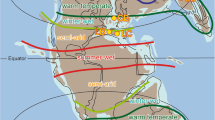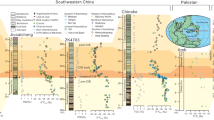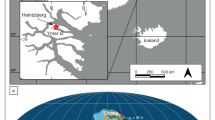Abstract
The end of the Triassic period was marked by one of the largest and most enigmatic mass-extinction events in Earth's history1 and, with few reliable marine geochemical records, terrestrial sediments offer an important means of deciphering environmental changes at this time. Tanner et al.2 describe an isotopic study of Mesozoic fossil soils which suggests that the atmospheric concentration of carbon dioxide (pCO2) across the Triassic–Jurassic boundary was relatively constant (within 250 p.p.m.v.), but this is inconsistent with high-resolution evidence from the stomatal characters of fossil leaves3. Here I show that the temporal resolution of the fossil-soil samples may have been inadequate for detecting a transient rise in pCO2. I also show that the fossil-soil data are consistent with a large increase in pCO2 across the Triassic–Jurassic boundary when variations in the stable carbon isotope (denoted as δ13C) in terrestrial plant leaves are taken into account. These factors suggest that the linkage between pCO2, global warming and the end-Triassic mass extinction remains intact.
This is a preview of subscription content, access via your institution
Access options
Subscribe to this journal
Receive 51 print issues and online access
$199.00 per year
only $3.90 per issue
Buy this article
- Purchase on Springer Link
- Instant access to full article PDF
Prices may be subject to local taxes which are calculated during checkout

Similar content being viewed by others
References
Hallam, A. & Wignall, P. B. Mass Extinctions and their Aftermath (Oxford Univ. Press, Oxford, 1997).
Tanner, L. H., Hubert, J. F., Coffey, B. P. & McInerney, D. P. Nature 411, 675–677 (2001).
McElwain, J. C., Beerling, D. J. & Woodward, F. I. Science 285, 1386–1390 (1999).
Royer, D. L., Berner, R. A. & Beerling, D. J. Earth-Sci. Rev. 54, 349–392 (2001).
Cerling, T. E. Glob. Biogeochem.Cycles 6, 307–314 (1992).
Ward, P. D. et al. Science 292, 1148–1151 (2001).
Hesselbo, S. P. et al. Geology (in the press).
Pálfy, J. et al. Geology 29, 1047–1050 (2001).
Marzoli, A. et al. Science 284, 616–618 (1999).
Hames, W. E., Renne, P. R. & Ruppel, C. Geology 28, 859–862 (2000).
Author information
Authors and Affiliations
Corresponding author
Rights and permissions
About this article
Cite this article
Beerling, D. CO2 and the end-Triassic mass extinction. Nature 415, 386–387 (2002). https://doi.org/10.1038/415386a
Issue Date:
DOI: https://doi.org/10.1038/415386a
This article is cited by
Comments
By submitting a comment you agree to abide by our Terms and Community Guidelines. If you find something abusive or that does not comply with our terms or guidelines please flag it as inappropriate.



